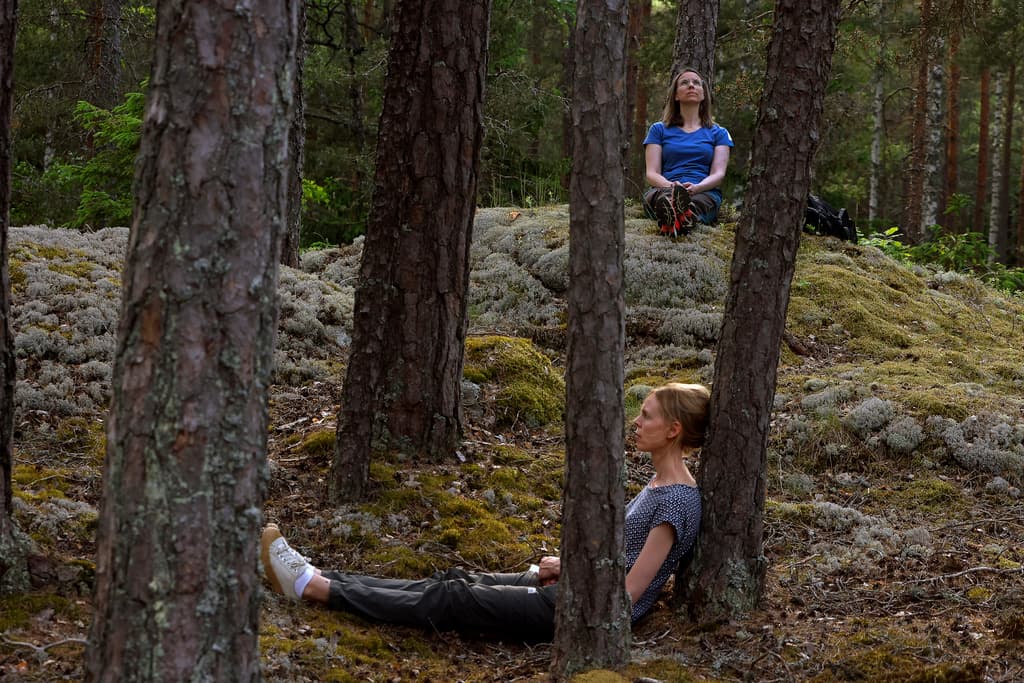Nature can help us find calm, many would agree. But does it make a difference to take a regular forest walk – and to take a "forest bath"?
Here are the tips for those who want to try the trend.
The smell of mosquito spray and the hum of E4 nearby. At first, it's not entirely easy to "take in the forest with all our senses", which is the task during our silent walk.
This is the first part of the forest bath organized by Friluftsfrämjandet this Friday evening. Most participants come directly from work and daily stress.
In the beginning, it's easy for thoughts to wander, but then it helps to focus on all the details in the forest, says leader Katarina Ahlskog.
After a while, other sounds and smells take over. Rustling from birch leaves, the scent of moss, and the crunch of steps in the blueberry bushes.
I heard the footsteps, which I never do otherwise, says participant Anna Ridderstad Wollberg, when we gather again after a ten-minute walk.
Counterweight to stress
The concept of forest bathing comes from Japan and was developed as a counterweight to the increasing stress in society. It's not about bathing in the usual sense, but about "bathing our senses". By focusing on what we see, hear, taste, and feel, it becomes easier to be present and recover, is the idea.
Many people feel good about being in the forest – and forest bathing is a way to let nature help us really be here and now, explains Katarina Ahlskog.
Exercise number two involves standing still and training one sense at a time. Afterwards, several participants think the impressions became clearer than usual. Like the rustling in the treetops or the scent of the nearby bog.
No forest needed
The forest where we are, in Rönninge south of Stockholm, resembles a fairy-tale forest and feels perfect for forest bathing. But the idea is that forest bathing can be practiced almost anywhere. You don't even need a forest. A few trees in a park or garden are enough, and it works just as well solo as in a group.
Katarina Ahlskog usually sits on the backside of her house.
I do it often when I'm stressed. For me, it works better than taking a walk, because then I just go too fast.
The question is whether it's not enough to just go out into the forest and enjoy – do you need to do it under the label "forest bathing"? Katarina Ahlskog thinks it makes a difference.
When you just go out into the forest, it's easy to grab your phone. And often when we're in the forest, for example, walking or cycling, we're set to be active. But we benefit from stopping and being present.
Reducing stress levels
Research also suggests that forest bathing can make us feel better. Several studies show positive effects on well-being, but there are limitations, such as the studies being difficult to compare since forest bathing can be done in different ways.
But the collective research clearly shows that forest bathing can lower stress levels and increase well-being. It can also lower pulse and blood pressure in healthy individuals, says Jenny Lovebo, lecturer in healthcare science at Linnaeus University in Växjö, who researches forest bathing.
What causes the effects, then? Partly, it may have to do with evolution, that we've learned to recognize certain forest environments and associate them with safety, thinks Jenny Lovebo.
Partly, it may be because the forest engages what's called our "spontaneous attention", rather than our "directed attention" which is triggered in urban environments or when we work.
In this way, the forest provides recovery that gives us energy to again direct our attention to a task, for example, says Jenny Lovebo.
"Spa feeling"
The final exercise during the forest bath in Rönninge is "stump sitting". Most choose to sit on the soft moss with their back against a tree, to take in the surroundings for a quarter of an hour.
The evening sun colors the pines red, and birdsong fills the air. Yet, sitting still without mobiles or other distractions can be challenging.
I had to strain myself not to fly away in thoughts. It was easiest to focus when the blackbird sang, says Anna Ridderstad Wollberg afterwards.
But the hour and a half of forest bathing helped to release daily stress, notes participant Hanna Bjärenstam:
I have an "after-spa feeling" in my body.
There are many ways to forest bathe. Here's a setup for those who find themselves in a natural area. Set a timer to avoid thinking about time.
1. Walk about a kilometer in silence. Focus on taking in the surroundings and all the details in nature – with all your senses.
2. Stand or sit still and train one sense at a time for two minutes, with closed eyes. What do you hear? How does it smell? What do you feel on your skin? Do you sense any particular taste?
3. Stump sitting: Sit still on a stump or on the ground for 15 minutes. Take in the surroundings with all your senses: Listen to the wind, the birds, and the rustling of leaves. Smell the scents. Look at the colors, how the light falls, and the branching of the trees. Taste the air or the forest floor. Feel the tree trunks or dip your toes in the water.
Source: Katarina Ahlskog, Friluftsfrämjandet
Forest bathing, or shinrin-yoku in Japanese, was coined in Japan in the early 1980s as a reaction to many Japanese people getting sick from stress. But also to create new opportunities for how the country's forests could be used.
Research suggests that forest bathing can positively affect well-being. However, many studies are relatively small, and more research is needed, especially regarding physiological effects, and there is no evidence that it works as a treatment for illnesses.
Source: Friluftsfrämjandet, SLU.






